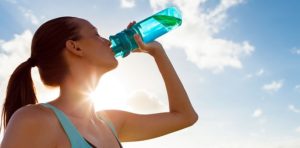Going for a swim in the summer can keep you cool when out in the sun. It can also benefit your health in several ways. Here are 5 reasons to hit the pool this summer:
- It offers a full-body resistance workout. In order to swim effectively, your body must incorporate the use of the muscles in your hands all the way down to your feet. The water offers resistance against the body that will help to keep your muscles strong.
- It promotes cardiovascular and lung health. Swimming laps in the pool can improve your heart’s ability to pump blood to the rest of the body. It can also improve lung capacity and efficiency.
- It reduces stress on the body and joints. Water provides buoyancy that lessens the impact of your body weight when swimming, providing a lower impact form of exercise than land based exercises such as running.
- It can decrease pain. Water can have a soothing effect on aching muscles and joints. It also promotes increased joint range of motion and body movement that may be difficult to perform on land if you have chronic pain.
- It is good for all ages and fitness levels. Whether you are young or old, in shape or out of shape, swimming is a fun way to help you achieve your fitness goals and keep you healthy.
Written by: Dr. David Reymann



